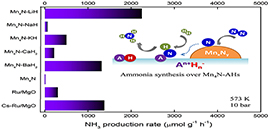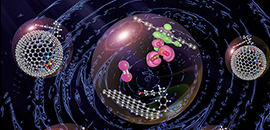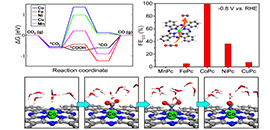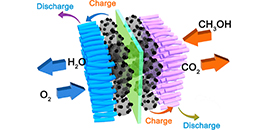Research News
-
10 26, 2018RNA thought to spread cancer shows ability to suppress breast cancer metastasisScientists discovered that a form of RNA called metastasis-associated lung adenocarcinoma transcript 1 (MALAT1) appears to suppress breast cancer metastasis in mice, suggesting a potential new area of therapeutic investigation.
MD Anderson mouse study demonstrates long non-coding RNA called MALAT1 as potential new area for clinical study
Researchers at The University of Texas MD Anderson Cancer Center have discovered that a form of RNA called metastasis-associated lung adenocarcinoma transcript 1 (MALAT1) appears to suppress breast cancer metastasis in mice, suggesting a potential new area of therapeutic investigation. The findings, published in the Oct. 22 online issue of Nature Genetics, were surprising given that MALAT1, a long non-coding RNA (lncRNA), previously was described as a metastasis promoter.
"Our six-year study unearthed the unexpected metastasis-suppressing function of MALAT1 through highly rigorous genetics approaches," said Li Ma, Ph.D., associate professor of Experimental Radiation Oncology and principal investigator for the study. "Our findings defy the conclusions drawn from previous MALAT1 studies and suggest the potential value of therapeutic agents targeting a cellular pathway linked to MALAT1. However, this will require further clinical investigation."
Halting a key protein behind metastasis
Ma's team observed that MALAT1 sequestered and inactivated a protein known as TEAD, a transcription factor, which when combined with a "co-activator" called YAP, causes cancer proliferation and metastatic progression. The researchers discovered that MALAT1 binds and inactivates TEAD, preventing it from partnering with YAP and targeting genes in promoting metastasis.
Although MALAT1 had been associated with metastasis, the team, using a breast cancer transgenic mouse model, inactivated the MALAT1 gene without altering expression of its adjacent genes and observed that MALAT1 inactivation promoted lung metastasis, which was reversed when MALAT1 was re-introduced.
Similarly, knockout of MALAT1 in human breast cancer cells induced their metastatic ability, which was reversed by the re-introduction of MALAT1. Additionally, overexpression of MALAT1 suppressed breast cancer metastasis in several mouse models.
"Taken together, our study reveals the unexpected function of MALAT1 through comprehensive gene targeting and genetic rescue approaches in multiple in vivo models," said Ma. "These findings call for a reassessment of ongoing efforts to target MALAT1 as an anti-metastatic therapeutic strategy, and provide a general framework for pursuing a better understanding of lncRNAs."
MD Anderson study team members included: Jongchan Kim, Ph.D., Hai-Long Piao, Ph.D., Fan Yao, Ph.D., Zhenna Xiao, Ashley Siverly, Sarah Lawhon, Baochau Ton, Hyemin Lee, Ph.D., Zhicheng Zhou, Ph.D., and Boyi Gan, Ph.D., all of the Department of Experimental Radiation Oncology; Mien-Chie Hung, Ph.D., Zhenbo Han, M.D., Ph.D., and Yutong Sun, Ph.D., of the Department of Molecular and Cellular Oncology; Yumeng Wang, Ph.D., and Han Liang, Ph.D., of the Department of Bioinformatics and Computational Biology; and M. James You, M.D., Ph.D., of the Department of Hematopathology.
Other participating institutions included: Dalian Institute of Chemical Physics, Dalian, China; Baylor College of Medicine, Houston; Hokkaido University, Sapporo, Japan; and China Medical University, Taichung, Taiwan.
The study was funded by the National Institutes of Health (RO1CA166051, R01CA181029, R01CA164346, R01CA20073, R01CA175486, U24CA209851, R01CA181196, and R01CA190370); the Cancer Prevention and Research Institute of Texas (RP150319, RP140402, and RR140033); The Stand Up to Cancer Innovative Research Grant (403235); the National Breast Cancer Foundation; and The University of Texas MD Anderson-China Medical University and Hospital Sister Institution Fund. (EurekAlert!) -
 10 25, 2018Scientists Develop Manganese-based Catalysts for Ammonia SynthesisA research team led by Prof. CHEN Ping and Dr. GUO Jianping from the Dalian Institute of Chemical Physics (DICP) of the Chinese Academy of Sciences and their collaborators developed high efficiency manganese-based catalysts for ammonia synthesis.
10 25, 2018Scientists Develop Manganese-based Catalysts for Ammonia SynthesisA research team led by Prof. CHEN Ping and Dr. GUO Jianping from the Dalian Institute of Chemical Physics (DICP) of the Chinese Academy of Sciences and their collaborators developed high efficiency manganese-based catalysts for ammonia synthesis.
Recently, a research team led by Prof. CHEN Ping and Dr. GUO Jianping from the Dalian Institute of Chemical Physics (DICP) of the Chinese Academy of Sciences and their collaborators developed high efficiency manganese-based catalysts for ammonia synthesis.
This research entitled "Alkali and alkaline earth hydrides-driven N2 activation and transformation over Mn nitride catalyst" was published in J. Am. Chem. Soc. (DOI: 10.1021/jacs.8b08334).
Ammonia synthesis over transition metals is very important in heterogeneous catalysis. Iron and ruthenium have moderate nitrogen adsorption energies, and therefore exhibit excellent ammonia synthesis performances and have been used extensively in industry.
Early transition metals such as V, Cr, and Mn, however, own strong nitrogen adsorption capability and usually form stable nitride phases under the reaction conditions of ammonia synthesis, which hinders the sequent hydrogenation steps and thus showing poor catalytic activities.
Based on previous research on ammonia synthesis, the scientists investigated the influence of alkali or alkaline earth metal hydrides (AH) on the catalytic performance of Mn-based catalysts.
Alkali or alkaline earth metal hydrides activate manganese nitride in ammonia synthesis catalysis. (Image by CHANG Fei)
Experimental results indicated that the catalytic activities of Mn-AH composites were 1-3 orders of magnitude higher than that of Mn catalyst itself. Among them, the performances of Mn-LiH and Mn-BaH2 were comparable to that of Ru-based catalyst.
The order of promotion effect of AH for Mn was different from that of conventional alkali or alkaline earth (hydr)oxide electronic promoters. Thermodynamic analyses and characterization results revealed that the phase transformation between alkali or alkaline earth metal hydrides and their imides, as well as their interactions with Mn nitride under the reaction conditions of ammonia synthesis should account for the promotion effect.
More detailed investigation on the activity-phase structure relationship of Mn-LiH catalyst indicated the active phases and kinetic behaviors of these composite catalysts strongly depended on the reaction conditions especially temperature and space velocity. This was another unique feature of these composite catalysts that was different from the conventional ammonia synthesis catalysts.
The research proposes a promising strategy for “activating” the early transition metals in ammonia synthesis catalysis.
This study was conducted in collaboration with Prof. LI Xingguo from Peking University. And it was supported by the National Natural Science Foundation of China, Sino-Japanese Research Cooperative Program of Ministry of Science and Technology, Collaborative Innovation Center of Chemistry for Energy Materials (iChEM), DICP DMTO, and Youth Innovation Promotion Association of Chinese Academy of Sciences. (Text by CHANG Fei and GUO Jianping) -
 10 24, 2018Scientists Review Recent Advanced in Flexible Perovskite Solar CellScientists published a review article on providing a comprehensive summary of the prior art with perspective discussion on application cost, potential opportunities and challenges in flexible perovskite solar cells.
10 24, 2018Scientists Review Recent Advanced in Flexible Perovskite Solar CellScientists published a review article on providing a comprehensive summary of the prior art with perspective discussion on application cost, potential opportunities and challenges in flexible perovskite solar cells.
With the rapid development of advanced technologies in the electronics industry, the demand for portable electronics, shaped display devices and wearable electronic textiles is ever increasing. Flexible solar cells are thereby receiving more and more attention for their favorable traits including flexibility, light weight, more portable and compatible with curved surfaces.
Mass production of flexible solar cells can be achieved by continuous roll-to-roll technology. Therefore, research on flexible perovskite solar cells has been accelerated, and the research field mainly focuses on how to improve efficiency, increase active area, reduce cost, make low-temperature preparation, and realize mass production.
Prof. LIU Shengzhong’s group from the Dalian Institute of Chemical Physics (DICP) of the Chinese Academy of Sciences achieved a series of innovations in perovskite solar cells, and repetitiously created an efficiency of world record for flexible, rigid planar-type and two-dimensional perovskite solar cells.
Recently, his group collaborated with Prof. YANG Dong’s group from Shaanxi Normal University published a review article on providing a comprehensive summary of the prior art with perspective discussion on application cost, potential opportunities and challenges in flexible perovskite solar cells.
Illustrated the structure of flexible perovskite solar cell, and showed its appication in wearable electronic devices. (Image by YANG Dong)
“We introduced and discussed the low-temperature fabrication technology for perovskite films as well as their advantages and disadvantages. And described the low-temperature interface materials (including electron and hole transport materials) applied in flexible perovskite solar cells in this review” said Prof. LIU.
Moreover, the review summarized the important development of various flexible electrodes in flexible perovskite solar cells, concluded the environmental and mechanical stability of flexible perovskite solar cells, and analyzed how to employ flexible encapsulation to improve environmental stability.
The flexible perovskite solar cells applied in portable electronic devices was prospected, and the cost of flexible perovskite solar cells fabricated by vacuum roll-to-roll technology was estimated. This review highlighted the opportunities and challenges of flexible perovskite solar cells.
The review entitled “Recent Advanced in Flexible Perovskite Solar Cell: Fabrication and Application” was published in Angew. Chem. Int. Ed..
The project was supported by the National Key Research and Development Program of China, National Natural Science Foundation of China, National University Research Fund and the 111 Project. (Text by YANG Dong) -
 10 22, 2018Single Cobalt Atoms Catalysts Developed for Efficient Fenton-like CatalysisA research team led by Profs. HUANG Yanqiang and ZHANG Tao at the Dalian Institute of Chemical Physics (DICP) of the Chinese Academy of Sciences collaborated with Prof. LIU Bin from Nanyang Technological University of Singapore reported their findings on developing single cobalt atom catalysts for efficient Fenton-like catalysis in J. Am. Chem. Soc.
10 22, 2018Single Cobalt Atoms Catalysts Developed for Efficient Fenton-like CatalysisA research team led by Profs. HUANG Yanqiang and ZHANG Tao at the Dalian Institute of Chemical Physics (DICP) of the Chinese Academy of Sciences collaborated with Prof. LIU Bin from Nanyang Technological University of Singapore reported their findings on developing single cobalt atom catalysts for efficient Fenton-like catalysis in J. Am. Chem. Soc.
Recently, a research team led by Profs. HUANG Yanqiang and ZHANG Tao at the Dalian Institute of Chemical Physics (DICP) of the Chinese Academy of Sciences collaborated with Prof. LIU Bin from Nanyang Technological University of Singapore reported their findings on developing single cobalt atom catalysts for efficient Fenton-like catalysis in J. Am. Chem. Soc. (DOI: 10.1021/jacs.8b05992) and it was selected as supplementary cover article.
Fenton-like process via activation of peroxymonosulfate (PMS) has been regarded as a promising strategy to deal with the ever-growing environmental pollution and the scarcity of fresh water resources resulted from rapid civilization and industrialization.
However, the development of improved catalysts with adequate activity and stability is still a long-term goal to realize their practical application. As radical predominant reaction, the half-life periods of most reactive oxygen-containing radicals generated from PMS activation are quite short. In this regard, approaches to minimize the migration distance of the reactive radicals to the target organic molecules are therefore highly desirable for maximizing the catalytic performance.
The proposed overall Fenton-like reaction mechanism on single-Co-atom catalyst.(Image by GUAN Jingqi)
The researchers reported single cobalt atoms anchored on porous N-doped graphene as highly reactive and stable Fenton-like catalysts for efficient catalytic oxidation of bisphenol A (BPA) via activation of PMS.
The single-Co-atom catalysts prepared in this work not only provide abundant CoN4 sites with optimal binding energy for PMS activation to produce singlet oxygen as active species, but also afford rich pyrrolic N sites for organics adsorption. The dual reaction sites greatly reduce the migration distance for the active species and thus improve the Fenton-like catalytic performance.
This study details the first insights into single-atom based catalysts for the Fenton-like reaction. Moreover, the proposed dual-reaction-site mechanism shall shed light on the development of other “single-atom catalysts”.
The research was supported by the National Key Projects for Fundamental Research and Development of China, the Strategic Priority Research Programme of the CAS.(Text by GUAN Jingqi) -
 10 22, 2018Scientists Reveal Reaction Mechanism of Electrocatalytic CO2 Reduction on Metal-N4 Sitesa team led by Prof. DENG Dehui in the State Key Laboratory of Catalysis of the Dalian Institute of Chemical Physics (DICP) of the Chinese Academy of Sciences explored the reaction mechanisms of electrocatalytic CO2 reduction reaction (CO2RR) to CO using well-defined metal-N4 sites.
10 22, 2018Scientists Reveal Reaction Mechanism of Electrocatalytic CO2 Reduction on Metal-N4 Sitesa team led by Prof. DENG Dehui in the State Key Laboratory of Catalysis of the Dalian Institute of Chemical Physics (DICP) of the Chinese Academy of Sciences explored the reaction mechanisms of electrocatalytic CO2 reduction reaction (CO2RR) to CO using well-defined metal-N4 sites.
Recently, a research team led by Prof. DENG Dehui in the State Key Laboratory of Catalysis of the Dalian Institute of Chemical Physics (DICP) of the Chinese Academy of Sciences and their collaborators explored the reaction mechanisms of electrocatalytic CO2 reduction reaction (CO2RR) to CO using well-defined metal-N4 sites.
Calculated free energy diagram of the intermediate structures and CO Faradaic efficiency at -0.8 V versus RHE for all MePcs. (Image by ZHANG Zheng and GAO Hehua)
Metal-containing nitrogen-doped carbon (metal-N-C) was found exhibiting promising electrocatalytic activity for CO2RR to CO. However, due to the great challenge in controllable synthesis of uniform and well-defined metal-N-C structures, the active sites and the reaction mechanisms are still under debate and need to be clarified. In addition, the optimum metal-N-C catalyst for CO2RR is still not determined.
Based on previous work on metal-N4 active sites and related catalytic reactions, the scientists found that metal phthalocyanines (MePcs) with well-defined metal-N4 structures could be used as model catalysts to study the underlying active centers and reaction mechanisms of electrochemical CO2RR.
In this study, they combined density functional theory calculations, electrochemical experiments and in situ XAS characterizations to explore the reaction mechanisms of electrochemical CO2 reduction reaction to CO using MePcs with well-defined metal-N4 sites.
Both theoretical and experimental studies identified CoPc as the optimum catalyst for selective CO2RR to CO among all the MePc candidates. The Co site in CoPc served as the active center and its high activity for CO2RR originates from the moderate *CO binding energy on the Co site which accommodated the *COOH formation and the *CO desorption. The optimized CoPc catalyst could achieve a maximal Faradaic efficiency of 99%, and maintained a long-term stability.
This study clearly illustrates the active center, reaction mechanism, and the activity trend on these well-defined metal-N4 sites, and paves a way towards rational design of highly efficient metal-N-C electrocatalysts for CO2RR.
The research entitled “Understanding the reaction mechanisms of well-defined metal-N4 sites in electrocatalytic CO2 reduction” was published in Angew. Chem. Int. Ed. (DOI: 10.1002/anie.201808593).
This work was conducted in collaboration with Dr. XIAO Jianping from Westlake University, Prof. TIAN Zhongqun and Prof. WANG Ye from Xiamen University, and Prof. SI Rui from Shanghai Institute of Applied Physics of the Chinese Academy of Sciences.
This work was supported by Ministry of Science and Technology of China, National Natural Science Foundation of China, Key Research Program of Frontier Sciences of the Chinese Academy of Sciences, and Collaborative Innovation Center of Chemistry for Energy Materials (2011. iChEM). (Text by ZHANG Zheng and GAO Hehua) -
 10 08, 2018DICP Scientists Develop New Hybrid Power Devices Based on Fuel Cells and SupercapacitorsA research group led by Prof. SUN Gongquan and Prof. WANG Suli from the Dalian Institute of Chemical Physics (DICP) of the Chinese Academy of Sciences invented a new electrochemical power sources based on the in-situ coupling of direct methanol fuel cells and supercapacitors. Their findings were published in ACS Energy Letters.
10 08, 2018DICP Scientists Develop New Hybrid Power Devices Based on Fuel Cells and SupercapacitorsA research group led by Prof. SUN Gongquan and Prof. WANG Suli from the Dalian Institute of Chemical Physics (DICP) of the Chinese Academy of Sciences invented a new electrochemical power sources based on the in-situ coupling of direct methanol fuel cells and supercapacitors. Their findings were published in ACS Energy Letters.
A research group led by Prof. SUN Gongquan and Prof. WANG Suli from the Dalian Institute of Chemical Physics (DICP) of the Chinese Academy of Sciences invented a new electrochemical power sources based on the in-situ coupling of direct methanol fuel cells and supercapacitors. Their findings were published in ACS Energy Letters.
Diagram of the hybrid electric power device (HEPD) and the comparison of the specific energy and power for the direct methanol fuel cells (DMFC) and HEPD. (Image by XIA Zhangxun)
High power density and high energy density are the key issues for the development of electrochemical power sources to meet the growing demands from a wide range of applications. However, most of the traditional power sources can hardly possess both features.
The commercialization of fuel cells is hampered by the relatively low specific power density, even though the energy density of fuel cells is great. On the other hand, the wide application of devices with high power density, such as supercapacitors, is also limited by the insufficient specific energy density. Hence, to develop alternative power sources with both high power and energy density is of great important for future energy researches and applications.
Based on previous studies on the key electrode materials, direct alcohol fuel cells and supercapacitors, the scientists for the first time coupled the voltage-sensitive PANI with the catalyst layers of direct methanol fuel cells (DMFCs).
As a result, the self-charging processes were achieved on the pseudo-capacitor of PANI. The ultra-fast discharging processes of PANI remarkably increased the pulse discharge current density of the hybrid power devices, whereas the constant methanol fuel feeding guaranteed the high energy density of the system.
This work sheds lights on the development of the next generation power sources for portable and vehicle applications.
The study was supported by National Key Research Project of the National Natural Science Foundation of China. (Text by XIA Zhangxun)